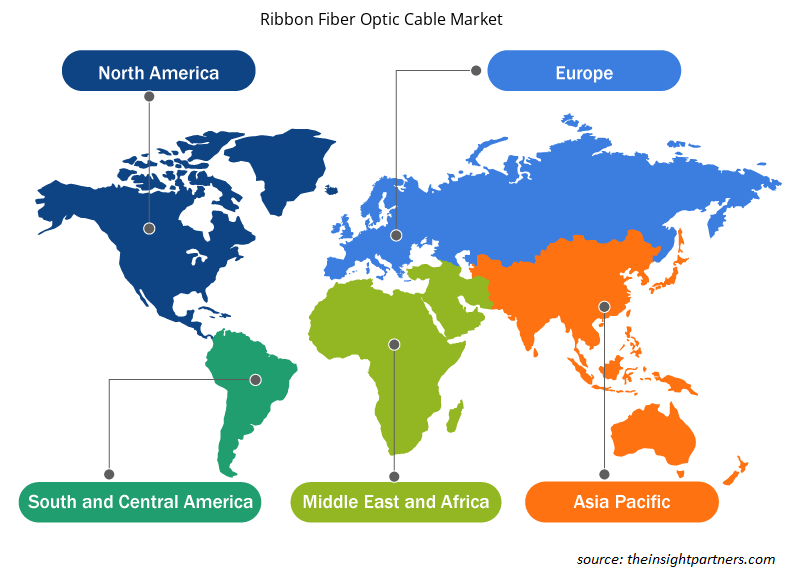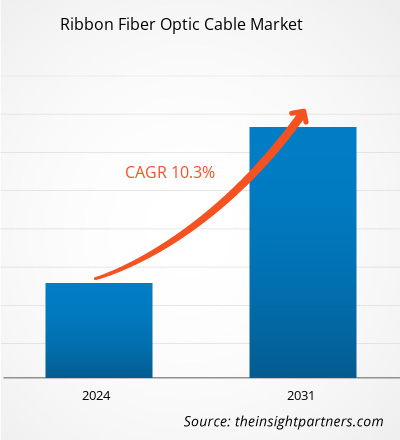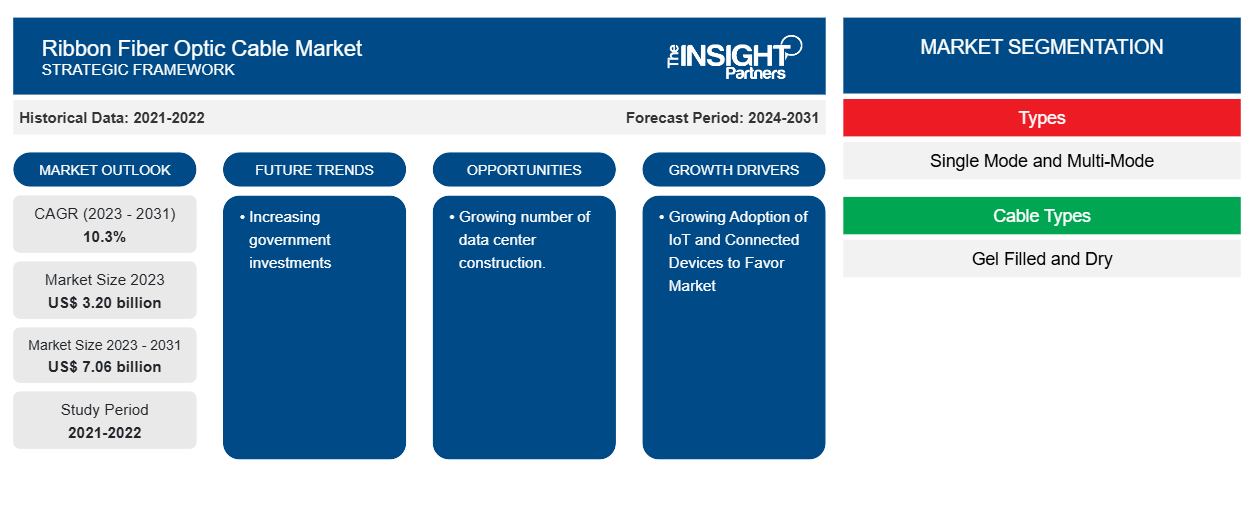Der Markt für Flachband-Glasfaserkabel soll von 3,20 Milliarden US-Dollar im Jahr 2023 auf 7,06 Milliarden US-Dollar im Jahr 2031 anwachsen. Der Markt soll zwischen 2023 und 2031 eine durchschnittliche jährliche Wachstumsrate (CAGR) von 10,3 % verzeichnen. Die steigende Nachfrage nach Flachband-Glasfaserkabeln in wachsenden Volkswirtschaften und die Zunahme der Zahl der gebauten Rechenzentren dürften weiterhin die wichtigsten Trends auf dem Markt für Flachband-Glasfaserkabel bleiben.
Marktanalyse für Flachbandkabel aus Glasfaser
Der globale Markt für Glasfaserkabel wird aufgrund ihrer weit verbreiteten Verwendung in zahlreichen Endverbrauchsbranchen wachsen. Die größere Reichweite und die höheren Bandbreitenverbindungen von Glasfaserkabeln werden voraussichtlich einen erheblichen Einfluss auf die Wachstumsstruktur des Marktes haben. Darüber hinaus wird erwartet, dass die starke Tendenz in der Rechenzentrums- und Telekommunikationsbranche die Wachstumsaussichten des Glasfaserkabelmarktes steigern wird.
Marktübersicht für Flachbandkabel
Flachbandkabel aus Glasfaser sind im Gegensatz zu optischen Strahlkabeln als Streifen angeordnet. Flachbandkabel aus Glasfaser sind eine praktische Lösung für Gewichts- und Platzprobleme. Wie eine kleine Version der in der Computerverkabelung verwendeten Drahtbänder bestehen die Kabelbänder aus beschichteten Glasfasern, die nebeneinander angeordnet und in Mylarband eingefasst sind. Da das Band nur aus beschichteten Glasfasern besteht, benötigt diese Art von Kabel viel weniger Platz als einzeln gepufferte Glasfasern. Flachbandkabel sind daher dichter als jede andere Kabelkonfiguration. Für Anwendungen mit Platzmangel sind sie perfekt geeignet.
Passen Sie diesen Bericht Ihren Anforderungen an
Sie erhalten kostenlos individuelle Anpassungen an jedem Bericht, einschließlich Teilen dieses Berichts oder einer Analyse auf Länderebene, eines Excel-Datenpakets sowie tolle Angebote und Rabatte für Start-ups und Universitäten.
-
Holen Sie sich die wichtigsten Markttrends aus diesem Bericht.Dieses KOSTENLOSE Beispiel umfasst eine Datenanalyse von Markttrends bis hin zu Schätzungen und Prognosen.
Treiber und Chancen auf dem Markt für Flachbandkabel
Zunehmende Nutzung von IoT und vernetzten Geräten begünstigt den Markt
In Schwellenländern steigt der Bedarf an Infrastruktur, darunter auch Telekommunikationsnetze. Glasfaserkabel mit Flachbandkabeln bieten eine höhere Dichte und sind einfacher zu installieren, was sie für den schnellen Ausbau von Netzwerken attraktiv macht. Mit der Modernisierung der Schwellenländer steigt auch die Nachfrage nach Internetkonnektivität, sowohl für Unternehmen als auch für Privatpersonen. Glasfaserkabel mit Flachbandkabeln können höhere Datenübertragungsraten unterstützen und ermöglichen so schnellere und zuverlässigere Internetverbindungen.
Immer mehr Rechenzentrumsbauten werden errichtet.
Die steigende Nachfrage nach einem stetigen Anstieg der Anzahl von Rechenzentren bietet eine Chance für den Markt für Glasfaserkabel mit Flachbandkabeln, da diese Kabel eine höhere Dichte und einfachere Verwaltung bieten und sich daher ideal für die hochdichten Umgebungen von Rechenzentren eignen. Sie können mehr Fasern auf kleinerem Raum unterbringen, was gut zu den Anforderungen expandierender Rechenzentren passt, die nach mehr Kapazität und Effizienz streben.
Segmentierungsanalyse des Marktberichts für Glasfaserbandkabel
Wichtige Segmente, die zur Ableitung der Marktanalyse für Flachbandkabel aus Glasfaser beigetragen haben, sind Typ, Kabeltypen und Anwendung.
- Basierend auf dem Typ wird der Markt für Flachbandkabel in Singlemode und Multimode unterteilt. Das Singlemode-Segment dürfte im Prognosezeitraum wachsen.
- Nach Anwendung ist der Markt in KMU und Großunternehmen segmentiert. Das Markensegment dürfte im Prognosezeitraum wachsen.
- Basierend auf den Kabeltypen wird der Markt für Glasfaserbandkabel in gelgefüllte und trockene unterteilt. Das gelgefüllte Segment dürfte im Prognosezeitraum wachsen.
Marktanteilsanalyse für Flachbandkabel nach geografischen Gesichtspunkten
Der geografische Umfang des Berichts zum Markt für Flachband-Glasfaserkabel ist hauptsächlich in fünf Regionen unterteilt: Nordamerika, Asien-Pazifik, Europa, Naher Osten und Afrika sowie Südamerika/Süd- und Mittelamerika. Nordamerika hat den Markt für Flachband-Glasfaserkabel dominiert. Hochtechnologische Trends in verschiedenen Branchen in der nordamerikanischen Region haben das Wachstum des Marktes für Flachband-Glasfaserkabel angekurbelt. Faktoren wie die zunehmende Einführung digitaler Tools und hohe Technologieausgaben von Regierungsbehörden werden voraussichtlich das Wachstum des nordamerikanischen Marktes für Flachband-Glasfaserkabel vorantreiben. Darüber hinaus zwingt eine starke Betonung von Forschung und Entwicklung in den entwickelten Volkswirtschaften der USA und Kanadas die nordamerikanischen Akteure dazu, technologisch fortschrittliche Lösungen auf den Markt zu bringen. Darüber hinaus gibt es in den USA eine große Anzahl von Akteuren auf dem Markt für Flachband-Glasfaserkabel, die sich zunehmend auf die Entwicklung innovativer Lösungen konzentrieren. All diese Faktoren tragen zum Wachstum des Marktes für Flachband-Glasfaserkabel in der Region bei.
Regionale Einblicke in den Markt für Flachbandkabel
Die regionalen Trends und Faktoren, die den Markt für Glasfaserbandkabel im Prognosezeitraum beeinflussen, wurden von den Analysten von Insight Partners ausführlich erläutert. In diesem Abschnitt werden auch die Marktsegmente und die Geografie von Glasfaserbandkabeln in Nordamerika, Europa, im asiatisch-pazifischen Raum, im Nahen Osten und Afrika sowie in Süd- und Mittelamerika erörtert.

- Erhalten Sie regionale Daten zum Markt für Flachbandkabel
Umfang des Marktberichts über Glasfaserbandkabel
| Berichtsattribut | Details |
|---|---|
| Marktgröße im Jahr 2023 | 3,20 Milliarden US-Dollar |
| Marktgröße bis 2031 | 7,06 Milliarden US-Dollar |
| Globale CAGR (2023 - 2031) | 10,3 % |
| Historische Daten | 2021-2022 |
| Prognosezeitraum | 2024–2031 |
| Abgedeckte Segmente |
Nach Typ
|
| Abgedeckte Regionen und Länder |
Nordamerika
|
| Marktführer und wichtige Unternehmensprofile |
|
Marktteilnehmerdichte: Der Einfluss auf die Geschäftsdynamik
Der Markt für Glasfaserbandkabel wächst rasant, angetrieben durch die steigende Nachfrage der Endnutzer aufgrund von Faktoren wie sich entwickelnden Verbraucherpräferenzen, technologischen Fortschritten und einem größeren Bewusstsein für die Vorteile des Produkts. Mit steigender Nachfrage erweitern Unternehmen ihr Angebot, entwickeln Innovationen, um die Bedürfnisse der Verbraucher zu erfüllen, und nutzen neue Trends, was das Marktwachstum weiter ankurbelt.
Die Marktteilnehmerdichte bezieht sich auf die Verteilung von Firmen oder Unternehmen, die in einem bestimmten Markt oder einer bestimmten Branche tätig sind. Sie gibt an, wie viele Wettbewerber (Marktteilnehmer) in einem bestimmten Marktraum im Verhältnis zu seiner Größe oder seinem gesamten Marktwert präsent sind.
Die wichtigsten auf dem Markt für Flachbandkabel tätige Unternehmen sind:
- CommScope, Inc.
- Corning Incorporated
- Fujikura Ltd.
- OFS Fitel, LLC.
- Prysmian SpA
Haftungsausschluss : Die oben aufgeführten Unternehmen sind nicht in einer bestimmten Reihenfolge aufgeführt.

- Überblick über die wichtigsten Akteure auf dem Markt für Flachbandkabel
Neuigkeiten und aktuelle Entwicklungen zum Markt für Flachbandkabel
Der Markt für Flachbandkabel wird durch die Erhebung qualitativer und quantitativer Daten nach Primär- und Sekundärforschung bewertet, die wichtige Unternehmensveröffentlichungen, Verbandsdaten und Datenbanken umfasst. Im Folgenden finden Sie eine Liste der Entwicklungen auf dem Markt:
- Im Oktober 2023 gab HFCL die Markteinführung seines intermittierend verbundenen Flachbandkabels 1728 bekannt. Das Unternehmen kündigte außerdem an, dass es die wachsende Nachfrage von Rechenzentren befriedigen und gleichzeitig die 5G-Netzwerkinfrastruktur stärken werde.
(Quelle: HFCL, Pressemitteilung, 2023)
- Im März 2024 gab Opticonx, ein in den USA ansässiger Hersteller von Glasfaserkabelkomponenten und -systemen und eine hundertprozentige Tochtergesellschaft von Precision Optical Technologies, eine exklusive globale Vertriebsvereinbarung mit Fiber Optic Center, Inc. (FOC) bekannt. Als Ergebnis dieser Partnerschaft wird FOC, ein führender internationaler Distributor von Glasfaserkomponenten, -geräten und -zubehör, dazu beitragen, die hochwertigen/innovativen LightTube-Glasfaser-Furkations- und Breakout-Rohrprodukte von Opticonx der breiteren optischen Netzwerkbranche zugänglich zu machen.
(Quelle: Opticonx, Pressemitteilung, 2022)
Marktbericht zu Glasfaserbandkabeln – Umfang und Ergebnisse
Der "Der Bericht „Marktgröße und Prognose für Flachbandkabel-Glasfasern (2021–2031)“ bietet eine detaillierte Analyse des Marktes, die die folgenden Bereiche abdeckt:
- Marktgröße und Prognose auf globaler, regionaler und Länderebene für alle abgedeckten wichtigen Marktsegmente.
- Marktdynamik wie Treiber, Beschränkungen und wichtige Chancen
- Wichtige Zukunftstrends
- Detaillierte PEST/Porters Five Forces- und SWOT-Analyse
- Globale und regionale Marktanalyse, die wichtige Markttrends, wichtige Akteure, Vorschriften und aktuelle Marktentwicklungen abdeckt.
- Branchenlandschaft und Wettbewerbsanalyse, einschließlich Marktkonzentration, Heatmap-Analyse, prominenten Akteuren und aktuellen Entwicklungen.
- Detaillierte Firmenprofile
- Historische Analyse (2 Jahre), Basisjahr, Prognose (7 Jahre) mit CAGR
- PEST- und SWOT-Analyse
- Marktgröße Wert/Volumen – Global, Regional, Land
- Branchen- und Wettbewerbslandschaft
- Excel-Datensatz
Aktuelle Berichte
Verwandte Berichte
Erfahrungsberichte
Grund zum Kauf
- Fundierte Entscheidungsfindung
- Marktdynamik verstehen
- Wettbewerbsanalyse
- Kundeneinblicke
- Marktprognosen
- Risikominimierung
- Strategische Planung
- Investitionsbegründung
- Identifizierung neuer Märkte
- Verbesserung von Marketingstrategien
- Steigerung der Betriebseffizienz
- Anpassung an regulatorische Trends























 Kostenlose Probe anfordern für - Markt für Band-Glasfaserkabel
Kostenlose Probe anfordern für - Markt für Band-Glasfaserkabel